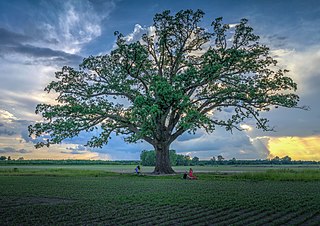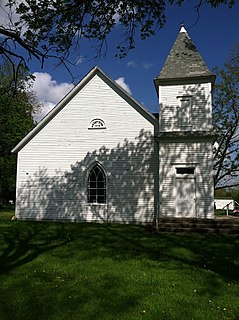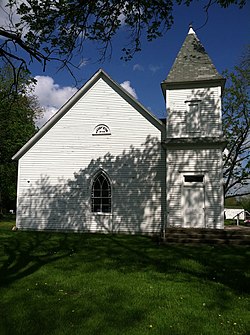
Boone County is located in the U.S. state of Missouri. Centrally located in Mid-Missouri, its county seat is Columbia, Missouri's fourth-largest city and location of the University of Missouri. As of the 2020 census, the population was 183,610, making it the state's eighth-most populous county. The county was organized November 16, 1820 and named for the then recently deceased Daniel Boone, whose kin largely populated the Boonslick area, having arrived in the 1810s on the Boone's Lick Road. Boone County comprises the Columbia Metropolitan Area. The towns of Ashland and Centralia are the second and third most populous towns in the county.

Hallsville is a city in Boone County, Missouri. It is part of the Columbia metropolitan area. The population was 1,614 at the time of the 2020 census. Southeast of the town is Mount Zion Church and Cemetery, the site of the Battle of Mount Zion Church during the Civil War.

Claiborne Fox Jackson was an American politician of the Democratic Party in Missouri. He was elected as the 15th Governor of Missouri, serving from January 3, 1861, until July 31, 1861, when he was forced out by the Unionist majority in the legislature, after planning to force secession of the state.

The Battle of Carthage, also known as the Engagement near Carthage, took place at the beginning of the American Civil War on July 5, 1861, near Carthage, Missouri. Franz Sigel, a colonel with military experience from Baden, commanded 1,100 Federal soldiers intent on keeping Missouri within the Union. Claiborne Fox Jackson, governor of Missouri, personally commanded and Sterling Price, a hero of Mexican–American War, led the pro-secessionist Missouri State Guard, which numbered more than four thousand soldiers alongside two thousand unarmed troops, who did not participate in the battle.

The First Battle of Boonville was a minor skirmish of the American Civil War, occurring on June 17, 1861, near Boonville in Cooper County, Missouri. Although casualties were extremely light, the battle's strategic impact was far greater than one might assume from its limited nature. The Union victory established what would become an unbroken Federal control of the Missouri River, and helped to thwart efforts to bring Missouri into the Confederacy.
The Battle of Roan's Tan Yard, also known as the Battle of Silver Creek, was a minor battle fought during the American Civil War on January 8, 1862, in Randolph County, Missouri. After back-and-forth operations throughout 1861, the pro-Confederate Missouri State Guard under the command of Sterling Price had been confined to southwestern Missouri. In December 1861, Price authorized recruiting and raiding activities in the central portion of the state, with the North Missouri Railroad being a major target. In January 1862, Major W. M. G. Torrence of the Union Army located a Missouri State Guard base in Randolph County and attacked it on January 8 with elements of four cavalry regiments. The camp, which was commanded by Colonel John A. Poindexter, put up little resistance and was soon overrun. Large quantities of supplies were captured in the abandoned camp, which was destroyed. The action at Roan's Tan Yard, along with a Missouri State Guard defeat at the Battle of Mount Zion Church the preceding December, led to a decrease in pro-Confederate activity in central Missouri.

The Missouri State Guard (MSG) was a military force established by the Missouri General Assembly on May 11, 1861. While not a formation of the Confederate States Army, the Missouri State Guard fought alongside Confederate troops and, at various times, served under Confederate officers.
The Centralia Massacre was an incident during the American Civil War in which 24 unarmed Union soldiers were captured and executed in Centralia, Missouri on September 27, 1864 by a band led by the pro-Confederate guerrilla leader William T. Anderson. Future outlaw Jesse James was among the guerrillas.

During the American Civil War, Missouri was a hotly contested border state populated by both Union and Confederate sympathizers. It sent armies, generals, and supplies to both sides, maintained dual governments, and endured a bloody neighbor-against-neighbor intrastate war within the larger national war.

The Battle of Athens was an American Civil War skirmish that took place in northeast Missouri in 1861 near present Revere and southeast Iowa along the Des Moines River across from Croton. The Union victory has the distinction of being the most northerly of Civil War Battles fought west of the Mississippi, and also of being the only such battle fought along the Iowa border.
The Battle of Cole Camp was a skirmish of the American Civil War, occurring on June 19, 1861, in Benton County, Missouri. The rebel victory assured an open line of march for the fleeing governor and Missouri State Guard away from Lyon's force in Boonville.
The Skirmish at Blackwater Creek, also known as the Skirmish at Milford, was an American Civil War skirmish that took place in central Missouri on December 19, 1861 near present-day Valley City. It was a victory for the North.
In the American Civil War the Home Guard or Home Guards were local militia raised from Union loyalists.

Mount Zion Church and Cemetery is a historic church and cemetery located east of Hallsville in Boone County, Missouri. The Gothic Revival style frame church was built in 1903. It was the location of the Battle of Mount Zion Church during the American Civil War. The cemetery contains over seven hundred grave sites, including many American Civil War soldiers. The grounds contain a memorial to the Missouri State Guard. The church is still functioning today.

Rocky Fork Township is one of ten townships in Boone County, Missouri, USA. The city of Hallsville is the largest settlement in the township.

Caleb W. Dorsey, or Colonel Caleb Dorsey, served in the Missouri State Guard and the Army of the Confederate States of America during the American Civil War. After the war he became a California State Assembly member between 1877 and 1878.
The capture of Sedalia occurred during the American Civil War when a Confederate force captured the Union garrison of Sedalia, Missouri, on October 15, 1864. Confederate Major General Sterling Price, who was a former Governor of Missouri and had commanded the Missouri State Guard in the early days of the war, had launched an invasion into the state of Missouri on August 29. He hoped to distract the Union from more important areas and cause a popular uprising against Union control of the state. Price had to abandon his goal of capturing St. Louis after a bloody repulse at the Battle of Fort Davidson and moved into the pro-Confederate region of Little Dixie in central Missouri.
The 13th Missouri Cavalry Regiment was a cavalry unit that served in the Confederate States Army during the American Civil War. In early April 1863, Captain Robert C. Wood, aide-de-camp to Confederate Major General Sterling Price, was detached to form an artillery unit from some of the men of Price's escort. Wood continued recruiting for the unit, which was armed with four Williams guns, and grew to 275 men by the end of September. The next month, the unit fought in the Battle of Pine Bluff, driving back Union Army troops into a barricaded defensive position, from which the Union soldiers could not be dislodged. By November, the unit, which was known as Wood's Missouri Cavalry Battalion, had grown to 400 men but no longer had the Williams guns. In April 1864, Wood's battalion, which was also known as the 14th Missouri Cavalry Battalion, played a minor role in the defeat of a Union foraging party in the Battle of Poison Spring, before spending the summer of 1864 at Princeton, Arkansas. In September, the unit joined Price's Raid into the state of Missouri, but their assault during the Battle of Pilot Knob failed to capture Fort Davidson.













